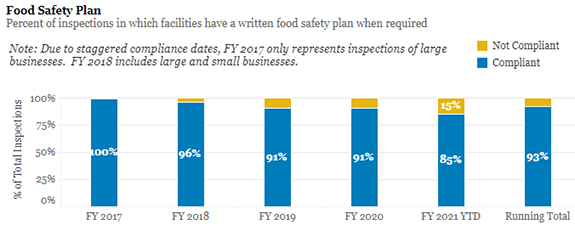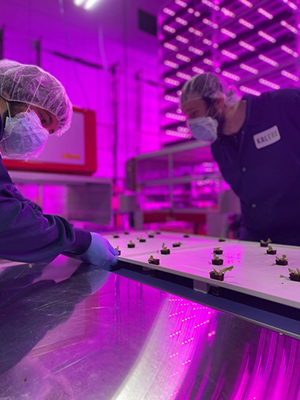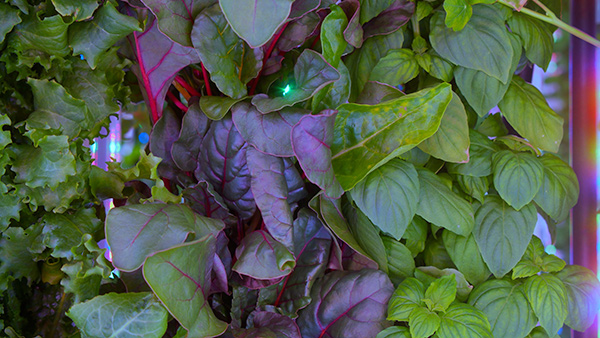45th Annual Plant Construction Survey -- FSMA and Facility Security
Processors up to speed on FSMA, but security issues remain
FSMA’s Intentional Adulteration rule is still a work in progress for some sites, meanwhile processors and retailers are eyeing indoor grow facilities

This propagation room starts leafy produce at one of Plenty Farms new facilities, an indoor vertical farm and a supplier to Walmart. Photo courtesy Walmart/Plenty Farms
Food Engineering’s Annual Plant Construction Survey asked architectural and engineering/construction (A&E/C) firms what issues in either food safety and/or security have changed facility design in the last year or two. As a follow-on question FE also asked whether there is a trend to move the growing of certain crops inside for any of several reasons, which might include more careful control of the growing environment and/or food safety/security issues. This article deals specifically with these issues. For more information on this year’s 45th Annual Plant Construction article, be sure to check out the story in the June 2022 e-magazine and online. Two additional articles, also part of the Annual Plant Construction Survey, will look at automation and site locations.
FSMA: Getting it right
“With FSMA passing the ten-year mark, food safety is incorporated by manufacturers and engineering firms alike into operations and design without second thought or confusion,” says David Ziskind, Black & Veatch NextGen Ag director of engineering.
In fact, according to FDA’s “FDA-Track: PC and CGMP Measures,” at the time of this writing, 93% of facilities inspected have a written food safety plan. This includes both large and small businesses (see graph immediately below).
 This graph shows in real time the number of facilities inspected, and what number have actually presented a written and working food safety plan to the FDA. Date of graph: 6 May 2022. Source: FDA
This graph shows in real time the number of facilities inspected, and what number have actually presented a written and working food safety plan to the FDA. Date of graph: 6 May 2022. Source: FDA
"Since the Food Safety Modernization Act (FSMA) was signed into law in 2011, food safety has been one of the predominant business cases for capital spending,” says Alex Garland, project manager, Burns & McDonnell. “Now ten years since FSMA was created, our clients are either up to speed or have put together a phased approach to achieve compliance and are currently in final phases of completion.”
“In general, our customers are up to speed on FSMA,” says Tyler Cundiff, president, Gray, Inc., Food & Beverage Group. “However, some do not have a deep technical team that can adequately assess the necessary measures to take during a new project initiative. They are sometimes more knowledgeable of FSMA as it relates to ongoing operations.”
Technologies have helped with food safety. For example, there has been increased interest in technologies that allow for continual sampling as opposed to manual scheduled swabbing for pathogens, adds Ziskind. Track-and-trace and traceability technologies continue to improve, which becomes the next step in food safety, allowing for verification of suppliers and tracing ingredients through the manufacturing process. “Transparency in this process is critical, and we are seeing development and integration of blockchain technologies gaining further validation and trust of the traceability process,” says Ziskind. Manufacturers can now pinpoint issues with a compromised ingredient in the finished product, such that in the event a recall becomes necessary, the affected finished product can be safely and confidently identified, while minimizing the impact of a widescale recall.
Beyond technology, processors are adapting with some taking even greater safety measures by researching Global Food Safety Initiative (GFSI) standards and receiving certifications such as SQF, adds Cundiff. Many fruit and vegetable processors are seeking Good Agricultural Practices (GAP) certification. GAP audits use FDA guidance measures to minimize microbial food safety hazards for fresh fruits and vegetables. GAP certification, like those certifications sought by food processors, is voluntary in nature and is designed to ensure that microbial hazards that may be introduced during production, packing, handling, and storage are minimized. Furthermore, growers are finding that their customers are now requiring these types of certifications to continue to address consumer concerns and transparency initiatives.
Part of FSMA spells out the rules for food hygiene. To maintain hygiene, food manufacturing facilities rely on physical segregation, personnel hygiene, and operational and environmental procedures, says Jason Robertson, CRB VP, food + beverage. Companies are showing a willingness to invest in a range of facility hygiene procedures to ensure food safety and product quality, with a focus on GMP. This includes separation between different production areas (e.g., between the raw side and the finish side), dedicated exchange rooms, and controlled access. One investment example is the industry adoption of captive shoe programs. These come with increased operational and construction costs, including separate spaces for storage and boot washing and the expense of stocking shoes for each employee and visitor.
FSMA’s IA (Intentional Adulteration) rule sets the stage for food security
FDA’s FSMA is a done-deal and the Intentional Adulteration rule was finalized in 2016, which means that “very small” processors (averaging less than $10,000,000, adjusted for inflation, per year) had five years to prepare their facilities to make them secure. According to Dan McCreary, Dennis Group senior partner, inspections for the IA rule are still underway, and some processors have been struggling to make their plants secure.
But, making facilities safe and secure from outside forces—and even internal—is not a new problem. Mark Redmond, president of Food Plant Engineering, contends that security in food facilities has been a concern for owners for years—and it remains so.
Many mitigation strategies can be managed through operational programs, but some companies have chosen to invest in security cameras (internal and external) and use of secured access areas to protect parts of a facility where they have identified a significant vulnerability, adds McCreary.
Additional security issues are not lost on Ronald L. Rens, Gleeson Construction & Engineers president. He lists several key methods to increase physical security, and therefore, enhance food security:
- Create more controlled access and security to processing facilities
- Use scan cards/fingerprints/facial recognition
- Increase the number of third-party audits, camera systems to monitor a facility
- Design facility spaces for separation of allergens and cleanrooms
- Create secured entrances to the job site
Rens suggests that COVID-19 has reminded processors and A&E/Cs of new things that need to be done. For example:
- Find ways to social distance when entering and exiting the plant
- Use temperature scanners with space to acclimate before temperature screenings
- Design and build larger breakrooms and locker rooms to give people space
“With the current political, social and economic climate, many of our clients continue to take measures regarding facility design to improve food safety and security above and beyond the requirements of FSMA,” says Burns & McDonnel’s Eric Hungerford, associate chemical engineer, Food & Consumer Products Group. In addition, facility security and cybersecurity are a paramount focal area within the owners’ organizations, oftentimes staffed with dedicated taskforce teams. Finally, there is an increasing emphasis on facility design measures, such as key card access to control access to specific areas of a facility, security checkpoints, controlled entry and exits (now with temperature monitoring to protect from COVID-19), camera systems, and automated contact tracing systems to protect both food as well as staff, says Hungerford.
Indoor growing spaces solve some problems but can create other issues
 Kalera has opened a new hydroponic vertical farm in Aurora, Colo., near Denver. The 90,000-sq.-ft. facility will grow pesticide-free and non-GMO lettuce and micro-greens for distribution in the area. The company also has farms in Orlando, Fla., Houston and Atlanta. Photo courtesy Kalera
Kalera has opened a new hydroponic vertical farm in Aurora, Colo., near Denver. The 90,000-sq.-ft. facility will grow pesticide-free and non-GMO lettuce and micro-greens for distribution in the area. The company also has farms in Orlando, Fla., Houston and Atlanta. Photo courtesy KaleraWhile FE didn’t officially track the number of indoor growing spaces—aka hydroponic, aquaponic, controlled environmental agriculture (CEA)—these facilities are becoming more popular for several reasons, and they can occupy brand new spaces or converted older facilities.
Controlled environment agriculture and the opportunity to do this on a local or even hyperlocal basis has benefitted from the impacts of the pandemic, says Black & Veatch’s Ziskind. Consumers are starting to demand documentation of a processor’s sustainability footprint, and controlled environment agriculture can be a method to reduce one’s impact. Hydroponic facilities can reduce the risk of contamination and pathogens on plants. One big impact of controlled environment agriculture is the ability to measure and control very specific variables, including light and nutrients. This provides a way to optimize growth of plants and subsequent yields, says Ziskind.
The emergence of the controlled environment agriculture industry continues to expand rapidly across the U.S. as produce is being grown indoors more efficiently, says Rick Elyar, director—business development, The Haskell Company. Where freshness and shelf life are key factors, indoor farming companies strategically locate their farms closer to large, urban areas where consumer demand is more significant and localized agricultural fields are less abundant, substantially shortening the time to market. Fruits and vegetables grown indoors through CEA provide consumers with healthier, food-safe products, says Elyar.
Controlled, indoor farming allows for better control of the environment (temperatures, humidity, and air flows), ensuring optimal growing conditions while being able to mitigate the risks of microbial contamination from water use, animal byproducts, herbicides, and pesticides, all elements that do not impact controlled, indoor farming facilities, adds Elyar. These operations are also reducing operating costs by being able to reuse nearly 95% of their water.
Pluses and minuses of CEAs
 This “grow wall” produces leafy produce at one of Plenty Farms new facilities, an indoor vertical farm and a supplier to Walmart. Photo courtesy Walmart/Plenty Farms
This “grow wall” produces leafy produce at one of Plenty Farms new facilities, an indoor vertical farm and a supplier to Walmart. Photo courtesy Walmart/Plenty Farms
"We have seen more work in the area of aquaponics and hydroponics,” says Chris Jarc, P.E., vice president, and manager, project management, Hixson Architecture & Engineering. It’s a growing trend that just makes sense: there is an increased demand for greens, production can be easily multiplied in a smaller amount of space than outdoors, and food is grown in a controlled space where it is protected against contamination better than in an outdoor environment. “Remember though that this does not mean that aquaponics and hydroponics will not have issues,” adds Jarc. “If the facilities are not designed and operated in a food-safe manner, then problems will still happen.”
Faithful+Gould has experienced an increased demand of indoor hydroponic facility projects, says Greg Franzen, program director, agrifood, Atkins North America dba Faithful+Gould, Inc. The benefits are growth of plants in a controlled environment, many annual harvest cycles and freshness of locally grown products year-round. Franzen notes that design issues seem to be humidity management and cost effective/availability of grow lighting. However, indoor grow facilities seem to be perceived as sustainable.
CMC Design-Build has worked extensively in the indoor farming segment over the past several years, says Nate Larose, director of project development. Indoor farms have many advantages over traditional farming but do require significant amounts of energy to create an environment that is suitable for growing plants. In particular, the design of the HVAC system is critical to ensuring that optimal temperature and humidity conditions are being met throughout the entire grow space. These systems can be extremely expensive to install, operate, and maintain if not properly designed.
“I see an increase in the interest in indoor grow facilities,” says Mark Galbraith, co-owner of Galbraith Pre-Design Inc. “Given proper design and attention to construction details, they are very efficient. And given the innovation and advancements in insulated metal panels (IMPs), coupled with a pre-engineered building structure, they are structurally very economical to construct. They do take a lot of energy, so the availability of utilities is important to consider during site selection.”
Finally, processors need to check potential locations thoroughly, and certain properties may have utility incentives. Often potential growers can find spec buildings or vacant distribution facilities and covert them to growth facilities, where there is already adequate power, says Jeff Jendryk, VP business development, Spec Engineering, A Gray Company. Grow facilities can increase their energy usage at night, which often the power companies will offer incentives. Not having to depend on weather, including mother nature problems like flooding and freezing, allows for the market to be sustainable. The cannabis market has really benefited from this business model.
A word of thanks
FE wishes to thank those A&E/C firms who have helped with the preparation of this article:
Atkins North America (dba Faithful+Gould, Inc.), Black & Veatch NextGen Ag, Burns & McDonnell, CMC Design-Build, CRB, Dennis Group, Food Plant Engineering, Galbraith Pre-Design, Gleeson Constructors & Engineers, Gray, Hixson Architecture & Engineering, , Spec Engineering—A Gray Company and The Haskell Company.
Looking for a reprint of this article?
From high-res PDFs to custom plaques, order your copy today!









